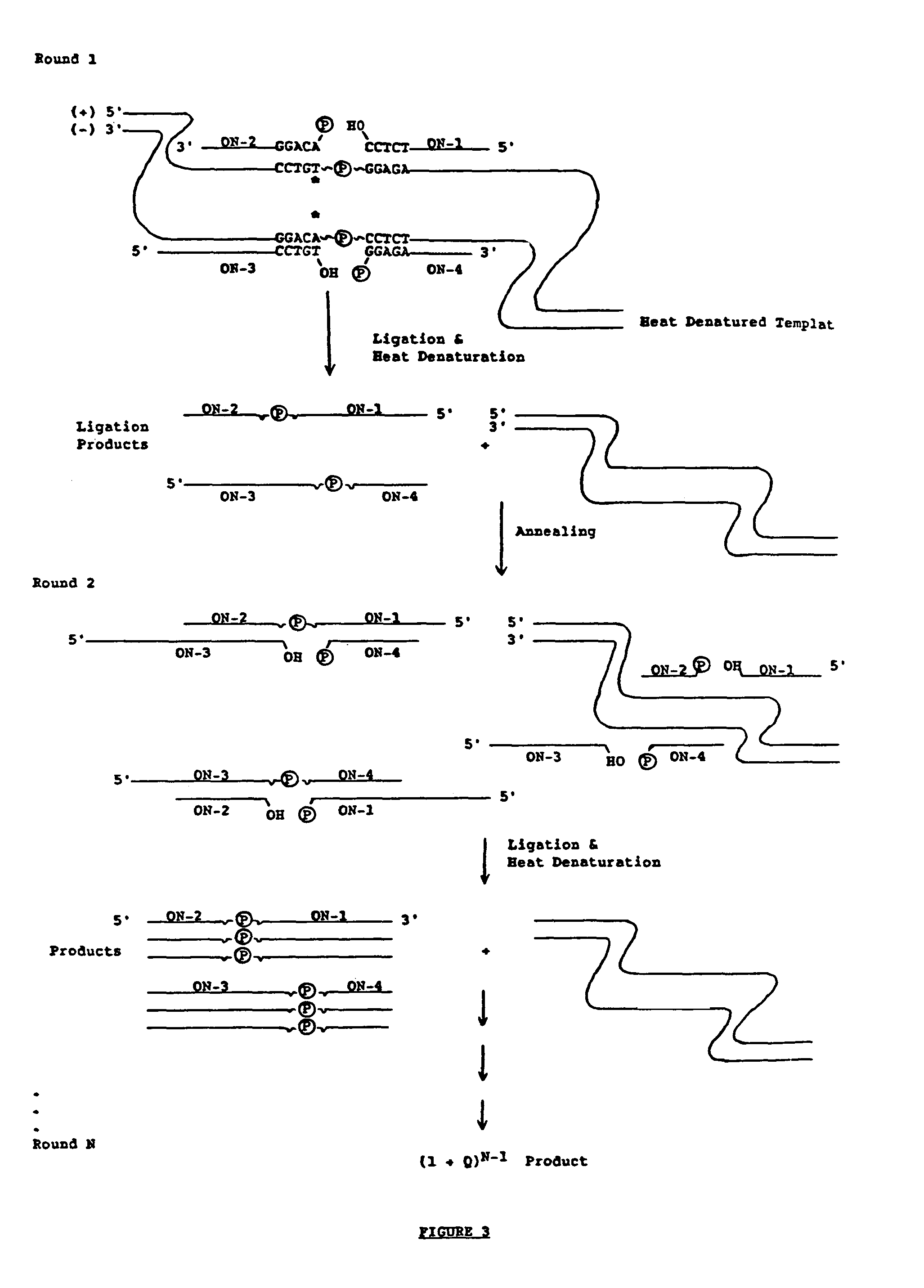Ligation amplification of nucleic acid sequences
a nucleic acid sequence and ligation technology, applied in the field of ligation amplification of nucleic acid sequences, can solve the problems of meliorated clinical course of disease, and achieve the effect of increasing the ligation product and suppressing the ligation under mismatched conditions
- Summary
- Abstract
- Description
- Claims
- Application Information
AI Technical Summary
Benefits of technology
Problems solved by technology
Method used
Image
Examples
example i
[0046]All oligodeoxyribonucleotide ligation reactions on oligo-nucleotide templates were carried out, unless otherwise indicated, in 50 mM Tris HCl (pH 7.6), 10 mM MgCl2, 1 mM DTT (dithiothreitol), 1 mM ATP, 200 mM NaCl and 5% PEG (polyethyleneglycol) with 5-10 μm of each substrate oligonucleotide mixed with a small amount of radioactively labeled 3′ oligonucleotide substrate (100,000-300,000 cpm) and the indicated amount of template.
[0047]Plasmid and genomic DNA template reactions are initiated following 5-10 minutes of boiling, cooling on ice and the addition of ligase (1 U; BRL). Unless otherwise indicated, all ligation reactions are withdrawn for electrophoresis and optionally treated with calf intestinal alkaline phosphatase (1-5 U) for 1-2 hours.
[0048]Linear amplification ligation of nucleic acid sequences is carried out by repeatedly using the original nucleic acid template (oligo, plasmid or genomic DNA) in each round of amplification. Only one flanking oligonucleotide set c...
example ii
[0059]ON1 / ONS2* and ONS3 / ON4* were ligated linearly on oligonucleotide templates using the above methodology. ONS2* and ONS4* are the same as ONS2 and ON4 except that they are only 6 nucleotides long. 10 pmoles of 32P-5′ phosphorylated ONS2* and unlabeled 5′ OH—ON1 (lanes a-d) or 32P-5′ phosphorylated ON4* and unlabeled 5′ OH—ONS3 (lanes e-h) were ligated on 19 base long or 23 base long oligonucleotide template respectively at 30° C. for 30 minutes with 1 U. of T4 DNA ligase in 10 μl reaction volume. FIG. 4 shows the results of the ligation amplification reactions described below. Samples in lanes a and e not treated with enzyme and samples in lanes b and f, without template, serve as negative controls. 1 pmole of the following oligonucleotide template was used: Hβ19S (c); Hβ19A (d); Hβ23S′ (g); and Hβ23A′ (h).
[0060]As seen in FIG. 4, the expected ligation involving sickle cell template and sickle cell substrates occurred (lanes c and g); ligation of normal (A) beta globin substrate...
example iii
[0061]The method of the present invention can also be used to exponentially amplify nucleic acid sequences. The major difference between exponential amplification ligation and the above-described linear amplification ligation is that all four flanking oligonucleotides (ON1 / ON2, and ON3 / ON4) are present as substrates during each reaction round. The ligation product of either flanking oligonucleotide set serves as the template for the other flanking oligonucleotide set in subsequent amplification rounds as shown in FIG. 3.
[0062]Radioactively labeled substrate for detection can be included in the starting materials or can be added in the last round.
[0063]As is also the case for linear amplification, an estimation of the number of amplification rounds needed to produce a detectable signal is preferably made before carrying out the exponential amplification. After n rounds, the product formation equals (1+x)n−1 where x is ligation efficiency. The following table indicates the relative am...
PUM
| Property | Measurement | Unit |
|---|---|---|
| Molar density | aaaaa | aaaaa |
| Nucleic acid sequence | aaaaa | aaaaa |
Abstract
Description
Claims
Application Information
 Login to View More
Login to View More - R&D
- Intellectual Property
- Life Sciences
- Materials
- Tech Scout
- Unparalleled Data Quality
- Higher Quality Content
- 60% Fewer Hallucinations
Browse by: Latest US Patents, China's latest patents, Technical Efficacy Thesaurus, Application Domain, Technology Topic, Popular Technical Reports.
© 2025 PatSnap. All rights reserved.Legal|Privacy policy|Modern Slavery Act Transparency Statement|Sitemap|About US| Contact US: help@patsnap.com



